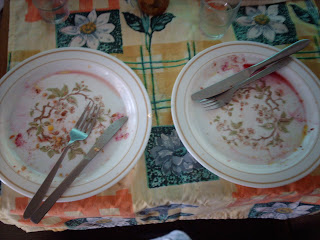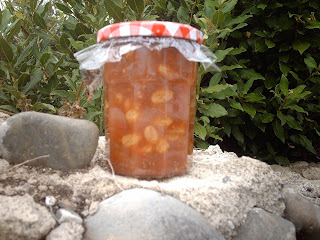 Finally it was time to go start raiding our small row of beetroot, left to fend for itself over the summer months, rarely watered, and quite frankly, neglected so I didn't have much hope for a good harvest. Much to my surprise, out of a quarter of the row I managed to get a small haul of veg, all of various size, from tiny to medium. (Tiny because they had been squashed up against the bigger beetroot and so couldn't grow- I have a dislike of thinning veg out!)
Finally it was time to go start raiding our small row of beetroot, left to fend for itself over the summer months, rarely watered, and quite frankly, neglected so I didn't have much hope for a good harvest. Much to my surprise, out of a quarter of the row I managed to get a small haul of veg, all of various size, from tiny to medium. (Tiny because they had been squashed up against the bigger beetroot and so couldn't grow- I have a dislike of thinning veg out!)So what to do with them: pickle them perhaps? But I didn't feel like doing that because of the various sizes, then I remembered a conversation with a friend of mine who said she had roasted them and they were delish. A quick search on the Internet fetched up with three suggestions, from which I chose my method.
Here is what I did:
1) As per Red Kitchen's suggestion (see Recipe 1 down below), after first removing the tops I peeled the beetroot with a potato peeler but had on rubber gloves to protect my hands. I also had on a pinny to stop my clothes from being splashed with beetroot juice, - I am messy when cooking!
2) Still with Red Kitchen: I cut them into chunks, 'splashing them with olive oil and red wine vinegar, plus salt and pepper'. Then into my Ramoska, which is a table top cooker.
3) Inspired by Recipe 2 from bbc.co.uk: I rummaged around in the bottom of my onion box and found some small red onions and a couple of small white onions. These I peeled. Out into the garden for some small pieces of thyme, I rubbed the leaves off the stems. All into the Ramoska. I forgot to put in the garlic as suggested, but did add of my own accord three small carrots (our first carrot harvest!) and a two medium sized potatoes which I peeled and cut into chunks. Into the Romaska these went.
 And with a thrill I observed these veg, because they had all come from our garden!
And with a thrill I observed these veg, because they had all come from our garden! Anyway, a quick roll round to coat the veg with olive oil and seasonings, then on went the lid of the Ramoska.
An hour later and voila!

Oh and by the way, I served the veg up with Chickpea Patties.
And here are the recipes which contributed to my learning curve about how to roast beetroot:
Recipe 1: Roasted beetroot.
- Take some fresh beetroots, preferrably from some loved one's garden, scrub the dirt off them and discard the leaves and stalks.
- Peel them and watch your fingers turn an attractive pink.
- Chop into manageble chunks (this is dictated a little by what you will be eating them with - a roast that will be a long time in the oven: big chunks which won't burn with the longer cookign time; want a roasted beet fix in a hurry: small chunks etc etc).
- Splash with olive oil and some vinegar-esque type stuff: I use red wine vinegar, because it has a clearer taste that the caramelly balsamic. Shallot vinegar would be good, too. Toss chunks and add a light sprinkle of salt and pepper.
- Bung the dish in the oven and roast the buggery out of it (a medium to hot oven) until cooked (try piercing one with a sharp knife). But don't let them burn!
- Excellent with roasts, in fritattas etc but also good in a mixed salad. Don't forget how spectacularly well beetroot goes with goats' cheese, so a leafy green salad with beetroot and goat's cheese is pretty luscious.
PS. Don't be alarmed by the *ahem* aftermath of eating a lot of beetroot at once - it tends to be same colour going out as it is going in : )
http://kitschenette.typepad.com/redkitchen/2006/09/roasted_beetroo.html
Recipe 2:
6 unpeeled beets
3 medium unpeeled red onions
4 unpeeled whole garlic cloves
sprigs of thyme
4 tbsp olive oil
For the glaze
chicken stock
2 tbsp balsamic vinegar
salt and freshly ground black pepper
1. Preheat the oven to 180C/360F/Gas 4.
2. Place the beetroot, red onions, garlic, sprigs of thyme and olive oil in a medium-sized roasting tray making sure that the vegetables are well coated in olive oil.
3. Roast for an hour and a half, until the beetroot feels tender. Peel and slice the cooked vegetables and put to one side.
4. To make the glaze, place the roasting tray on a medium hob flame and deglaze by adding approximately two tablespoons of chicken stock, the balsamic vinegar and a teaspoon of chopped thyme
5. Bring this to the boil making sure to stir until the liquid has reduced to a syrupy consistency. Season.
6. Arrange the beetroot, red onions and garlic neatly on a warmed serving dish and cover in the glaze. Serve immediately.
http://www.bbc.co.uk/food/recipes/database/roastbeetroot_72797.shtml
Recipe 3:
Banish all thoughts of vinegared beetroot from your mind. Roasted beetroot is mellow and delicious, and can be cooked an hour or so before the guests arrive.
8-10 tennis ball-sized fresh beetroots, ideally red and yellow (golden), cut into quarters
2 tbsp olive oil
1 tbsp fresh thyme leaves
- Pre-heat the oven to 375F/190C/gas mark 5.
- Toss the beetroot wedges with the olive oil, thyme leaves and salt and pepper, so that they are well coated. Tip them into a shallow roasting tin. Roast for about 40-45 minutes until they are charred around the edges and tender.
- Serve warm (not hot) or cooled to room temperature.
- Aga directions: prepare the beetroot as above, and hang the roasting tin on the second set of runners in the roasting oven. Cook for 15-20 minutes until the beetroot wedges are charred around the edges and tender.
http://www.telegraph.co.uk/foodanddrink/recipes/5195742/Roasted-beetroot-recipe.html













